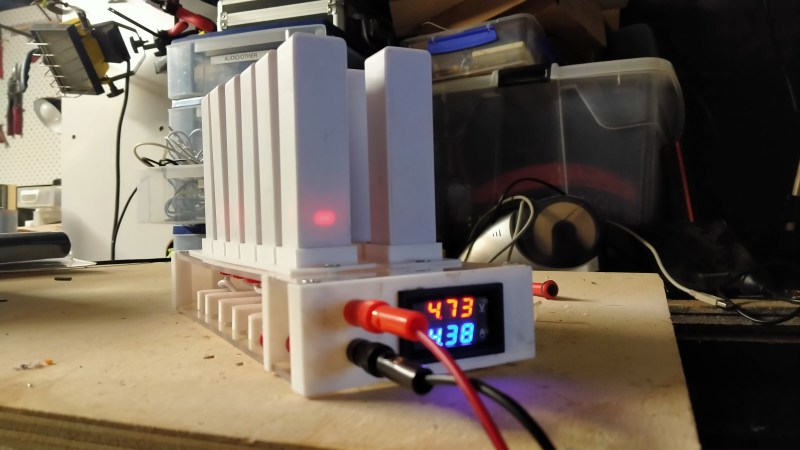[jasonwinfieldnz] uses twelve small powerbanks day to day – powering LED strips around his trampoline, presumably, to avoid the mess of wires and make the assembly easily portable. However, if you have twelve powerbanks, you’ll find yourself hogging all the household’s microUSB cables every so often, as they eventually discharge. This was not good enough for our hacker, and he decided to build a charging station to refill them all at once.
If you need 5 volts and many amps, an ATX PSU isn’t your worst bet. From there, he only had to add twelve microUSB connectors to – and condensed the entire contraption into a beautiful charging station. For the microUSB part, he hacked some microUSB cable ends off and embedded them into the case. An embedded voltage and current module is of big help – letting you see at a glance when charging has really finished. Using copper tape as bus bars and banana plugs for charging input, this project is easy to build and solves the problem well.
The 3D printing files and cutting templates are right there on the project page, so if any of us hackers has a problem that twelve powerbanks could help with, [Jason]’s project is quite repeatable. If your devices are more diverse, you could use a pegboard to build a stylish charging station for them! If, on the other hand, you have a single device you need to plug multiple cords into, moldable plastic is there to help.
















No current limiting to each power bank. That sure is a good way to start a fire.
Should at least have a fuse for each power bank.
Don’t you think the individual powerbanks have a BMS built in that will take care of that?
The issue here isn’t current draw from the cell, but from the battery pack circuitry. If it becomes a short, that’s a lot of current to vaporize components.
Power banks usually have lithium battery protections built into the charging chip.
Trouble starts when one of them decides to fail. It doesn’t happen often, but good to keep in mind.
If you have this many power banks stacked together, fire on one of them could trigger more.
It might be far fetched, but better safe than sorry and at least make sure everything is limited to the amount of current the connector is designed for.
Besides that, 3D printed parts are unsuitable for things that can get hot in case of failure. 3D materials usually contain no flame retardant additives, melt away when overheated and spit burning drops when on fire.
Each has a BMS. So far, so good
Hmm… I think I would have gone with the solar charging solution since it is going to be sitting outside every single day. A small panel at the top of each post would capture plenty of energy.
Hmm…. Have you had much experience with solar panels? Unless they’re big, they’re usually rubbish.
Also were back to fire-related issues if we’re leaving batteries in the sun.
Then get good solar panels, they’ll be large enough to provide plenty of shade for those batteries ;) And cover fron the rain too!
I wonder how well the 3D printed slide in pack seats that hard-to-feel and insert micro USB plug without eventual damage. I’d prefer some standard like the smaller DC coax barrel jack. I have to use micro USB to charge a mounted light on my bike, ugh. Easier done with both hands in front of your eyes to check alignment which sometimes needs an angled start to get the blade to go in even then it’s a creepy feel to find it working or not.
The fitting is tight, probably too tight. Agreed it would be better not to use the micro usb so I am modifiing them to fit in a two prong adapter. More details here: https://youtu.be/TqNXw07xhCg
I would probably try to make this a scalable load by throwing in some chips of the CD4000 series, some logic level Mosfets, and two push buttons:
link
(the link is rather long, but it contains all the circuitry, hopefully it works)
Ok, it is not necessary for only loading all power banks at once, but it generates a variable (big) load with small loads, which are switched on and off, and with pretty good power cycle distribution across the small loads.